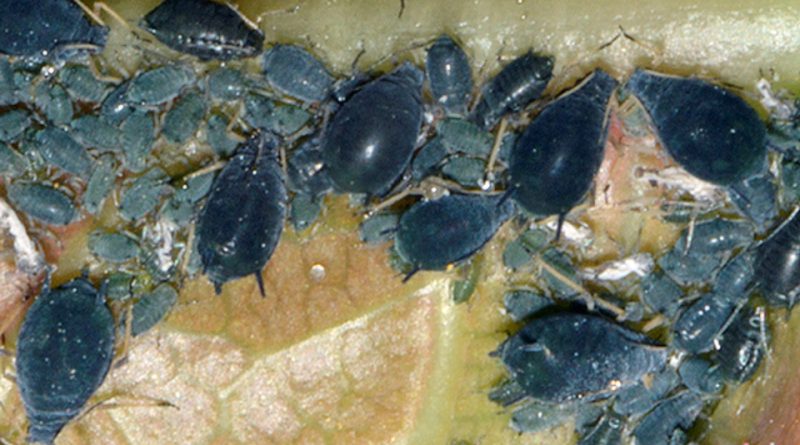Aphis gossypii
Aphis gossypii
The dark green aphid (Aphis gossypii Glov.), Also known by the names of cotton aphids, aphid of the melon and aphid of cotton and melon, is an insect rincote of the family Aphididae.
Systematic –
From a systematic point of view it belongs to the Eukaryota Domain, Kingdom Animalia, Eumetazoa Subarray, Bilateral Branch, Phylum Arthropoda, Subphylum Hexapoda, Insecta Class, Pterygota Subclass, Exopterygota Cohort, Subcoorte Neoptera, Paraneoptera Superorder, Rhynchotoidea Section, Rhynchota Order, Suborder Homoptera, Section Sternorrhyncha, Superfamily Aphidoidea, Family Aphididae, Subfamily Aphidinae and therefore Gender Aphis and Species A. gossypii.
Geographic Distribution and Habitat –
The origin of the Aphis gossypii is not known where but now it is found in the tropical and temperate regions of the whole world except the extreme northern areas. This aphid is common in North and South America, Central Asia, Africa, Australia, Brazil, the East Indies, Mexico and Hawaii and much of Europe. It is a species with a cosmopolitan habitat. And in the northernmost areas it survives and is prolific in greenhouses.
Morphology –
The Aphis gossypii is a very polyphagous Afide with an adult measuring approximately 2 mm in length and with a very variable color, from greenish to dark grayish. The juvenile forms are almost always yellowish in color.
Attitude and biological cycle –
The Aphis gossypii infest the inferior page of the leaves, provoking, through the suction of the lymph, the yellowing and the desiccation. It also attacks the flowers, determining their wilting, and the fruits, hindering their growth. In general the plants affected by this insect show a general stunted development. Moreover, as the Afide produces an abundant honeydew that recalls the ants that establish a symbiotic role with it, spreading and protecting it. The presence of the honeydew thus causes indirect damage due to asphyxiation, burns due to lens effect and, finally, favors the establishment of the fumigations that further aggravate the damage. To these biosgna damages add those caused by the diffusion, that the Aphis gossypii plays, of some viruses like that of the Mosaico del Cetriolo, of the Cocomero, and other virosis of the vegetable plants like the onion and the potato. This aphid can winter as an egg on primary arboreal hosts (Catalpa, Hibiscus) or, in the most favorable climates, as an anocyclic or paraciclic adult female.
It is a cosmopolitan parasite and present on many varieties of agricultural crops of the families of the Cucurbitaceae, Rutaceae and Malvaceae.
Ecological role –
The Aphis gossypii is a polyphagous insect and has a very wide range of guests, with around 700 species worldwide. Among the cucurbits, it can seriously affect watermelons, cucumbers, melons and various types of pumpkins. Other crops affected by its attacks include: peppers, aubergines, okra and asparagus, it also affects citrus fruits, cotton and hibiscus.
The impact of dark green Aphid is particularly important on plant crops such as zucchini, melons, cucumbers, aubergines and strawberries and on cotton, citrus and mauve.
The fight against Aphis gossypii is unfortunately chemical, especially where specialized crops, without principles and rules of agroecology, do not allow another type of struggle. However, it should be noted that in nature, this aphid is controlled by various predatory entomophagi – parasitoids (Crisopid Neuroptera, Coleoptera Coccinellidae, Diptera Syrfidi and Cecidomidi and Hymenoptera) and entomopathogenic fungi; however, natural control, especially if the use of plant protection products has reduced the useful entomofauna, can have mild effects. In a protected culture, biological control can be activated with the introduction of entomophages. The real fight, however, is a preventive and agroecological organization of crops. The decrease in agricultural specialization, the use of hedges and host species of its predators, the grassing and the reduction (or elimination) of nitrogenous nitrogenous fertilizers are the only long-term and ecologically correct remedy.
Guido Bissanti
Sources
– Wikipedia, the free encyclopedia.
– Russo G., 1976. Agricultural Entomology. Special Part. Liguori Editore, Naples.
– Tremblay E., 1997. Applied entomology. Liguori Editore, Naples.

